Do you have a question about the Campbell Hausfeld WG3060 and is the answer not in the manual?
Details on how to unpack the welder and check for damage, plus electrical circuit requirements.
Identification and function of key components like work clamp, gun, cord, and controls.
Explanation of hazard classifications: DANGER, WARNING, CAUTION, and NOTE.
Warning that the torch has current when ON and advice to keep a fire extinguisher accessible.
Precautions against electric shock and injury from sparks, light, heat, and fumes.
Warnings about igniting flammable materials and risks from welding closed cylinders.
Warnings about toxic fumes, gas cylinder dangers, and handling.
Warnings on electromagnetic fields and safe cable handling.
Guidance on choosing location, ventilation, and power supply connection.
Steps for assembling the handle, wheels, axle, and gas cylinder bracket.
Instructions for assembling the foot and the work clamp.
Detailed steps for installing welding wire and routing it through the system.
Information on the torch nozzle and wire size compatibility.
Settings for wire size, polarity, and instructions for helmet assembly.
Safety warnings regarding compressed gas cylinders and high pressure.
Procedure for connecting shielding gas and using the regulator.
Safety checks before operation and guidance on wire handling.
Steps for setting heat/speed, and starting the welding process.
Maintenance safety, disconnection, routine checks, and wear parts.
Information on nozzles and changing wire sizes for different applications.
Explanation of welding processes and weld components.
Fundamental techniques affecting weld quality and heat setting adjustments.
Guidance on choosing wire, and the importance of weld angle.
Importance of tuning wire and travel speed for optimal welds.
Procedure for removing slag and description of welding positions.
Visual guide to welds, weld passes, and push vs. pull techniques.
Specific requirements for aluminum welding and supply cable replacement.
Steps for diagnosing and resolving no output, wire feed, and aluminum wire problems.
Steps for diagnosing and resolving issues with weld bead thickness, edges, penetration, and sputtering.
Information on warranty duration for components and what is covered.
Details on what is not covered and the responsibilities of the warrantor and purchaser.
Instructions for addressing parts correspondence and lists of optional wire/tips.
Definition of electric current that reverses direction periodically.
Definition of the distance from electrode end to workpiece contact point.
Definition of the material to be welded.
Definition of a joint between two members aligned in the same plane.
Definition of a pool or pocket formed by arc contact with base metal.
Definition of electric current flowing in only one direction.
Definition of electrode connected to positive pole, directing heat to electrode.
Definition of electrode connected to negative pole, directing heat to workpiece.
Definition of a coated metal wire similar to the material being welded.
Definition of a weld joining two surfaces at right angles.
Definition of a coating that produces shielding gas when heated.
Definition of gasless welding using tubular wire with flux material.
Definition of MIG welding using solid wire and inert gas shielding.
Definition of TIG welding using a non-consumable tungsten electrode.
Definition of a joint between two overlapping members in parallel planes.
Definition of voltage between electrode and work clamp when not welding.
Definition of molten metal falling without fusing due to low amperage.
Definition of gas pockets or cavities formed during weld solidification.
Definition of the depth into the workpiece heat-affected by the arc.
Definition of Stick welding using a consumable electrode with flux coating.
Definition of flux soot protecting the weld from oxides during cooling.
Definition of metal particles thrown from the weld that cool and harden.
Definition of a weld made to hold parts in alignment before final welds.
Definition of the angle of the electrode in the line of welding.
Definition of a joint made by placing one piece edge on another at 90 degrees.
Definition of a groove in base metal due to excessive welding amperage.
Definition of a volume of molten metal before solidification.
Definition of a layer of metal deposited on the base metal as the electrode melts.
Definition of the electrode angle from horizontal, measured at right angles to the weld line.
| Input Voltage | 120V |
|---|---|
| Input Current | 20A |
| Welding Process | MIG (GMAW) |
| Duty Cycle | 20% at 90A |
| Maximum Welding Thickness | 1/8 in. (3.2 mm) |
| Weight | 38 lb (17.2 kg) |
| Amperage Range | 30-90 A |
| Wire Size | 0.030 in. (0.8 mm) |
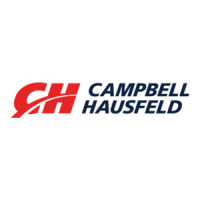
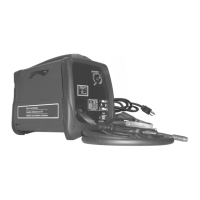
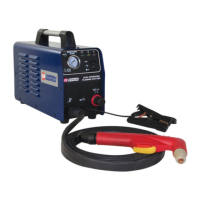

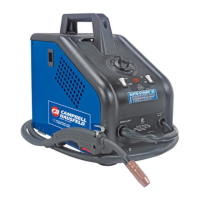
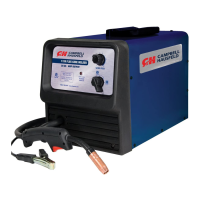
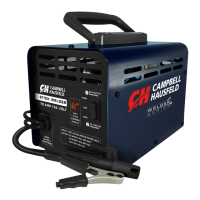
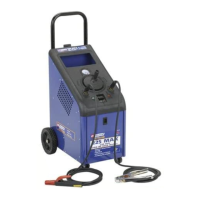
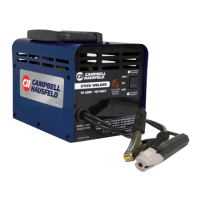

